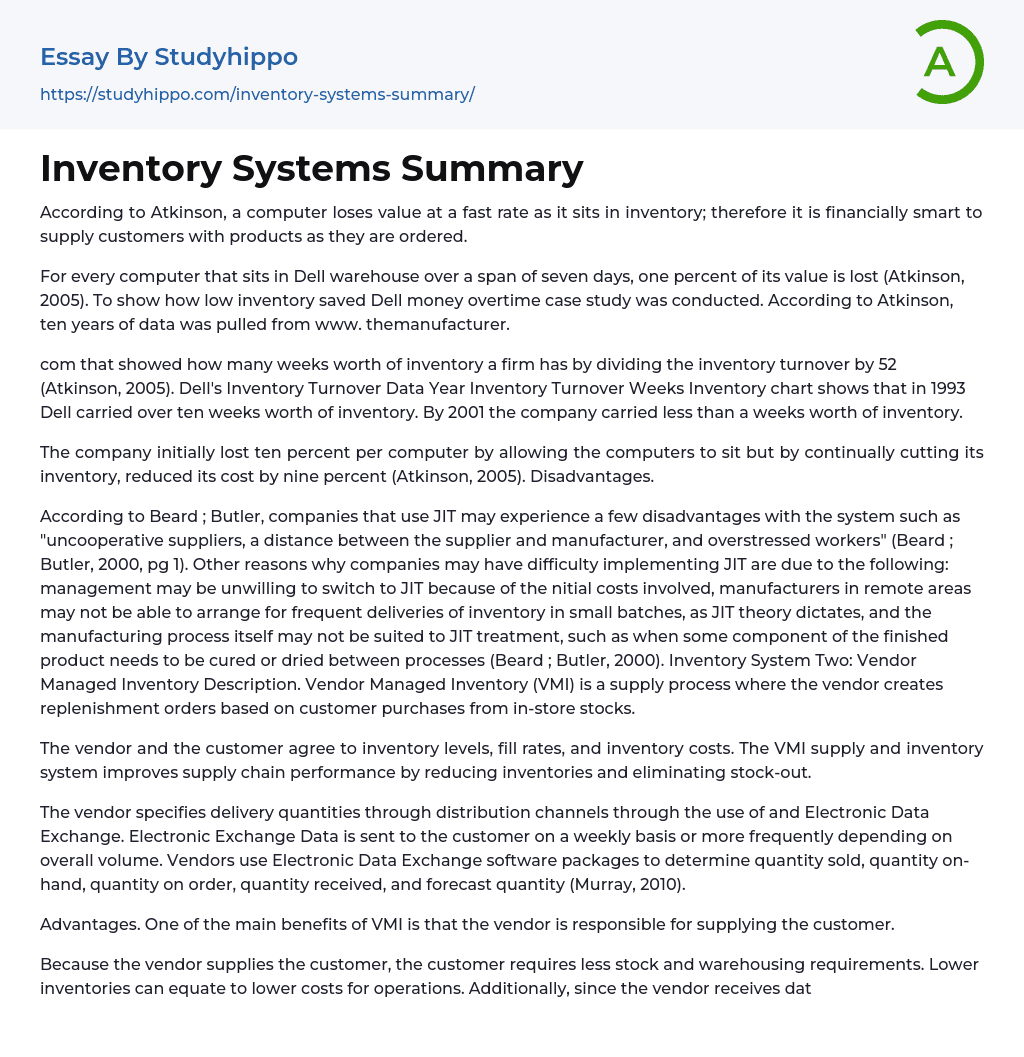Atkinson (2005) suggests that the longer a computer sits in inventory, the more its value decreases. Thus, it is financially beneficial to supply customers with products as they are ordered. For every computer that remains in Dell's warehouse for seven days, one percent of its value is lost. Atkinson (2005) conducted a case study using ten years of data from www.themanufacturer.com, which showed a firm's inventory turnover divided by 52 weeks, to demonstrate how low inventory saved Dell money over time. Dell's Inventory Turnover Data Year Inventory Turnover Weeks Inventory chart reveals that in 1993, the company carried over ten weeks' worth of inventory. By 2001, however, Dell carried less than a week's worth of inventory and reduced its cost by nine percent, as opposed to initially losing ten percent per computer by allowing them to sit. According to Beard and Butler (2000), companies that use Just-In-T
...ime (JIT) may face some disadvantages including "uncooperative suppliers, a distance between the supplier and manufacturer, and overstressed workers" (p. 1).
Several factors can make it difficult for companies to implement JIT, including management reluctance to incur initial costs, challenges faced by remote manufacturers in sourcing inventory in small batches, and unsuitability of the manufacturing process for JIT applications (Beard & Butler, 2000). Vendor Managed Inventory (VMI) is a supply process where vendors create replenishment orders based on customer purchases from in-store stocks. Vendors and customers agree on inventory levels, fill rates, and related costs. The VMI system enhances supply chain efficiency by reducing inventory levels and avoiding stockouts. To determine the desired delivery quantities through distribution channels, vendors use Electronic Data Exchange software. They communicate Electronic Dat
Exchange on a weekly or more frequent basis based on overall volume. Vendors use the software to find out the quantity sold, quantity on-hand, quantity on order, quantity received, and forecasted quantity (Murray, 2010). Among the significant advantages of VMI is that suppliers are responsible for ensuring customer supplies.The supplier's provision of goods to customers can lead to reduced inventory and warehousing requirements, resulting in lower operational costs. In addition, there are significant savings in operational costs for purchasing departments as vendors receive data instead of purchase orders. This eliminates the need for purchase order reconciliation. However, the main disadvantage of Vendor Managed Inventory (VMI) is that control is relinquished to the vendor, which removes significant oversight. Furthermore, the reliance on electronic systems with VMI makes it vulnerable to computer and other electronic malfunctions.
The Perpetual Inventory Method (PIM) is widely used by financial institutions to ensure an accurate record of goods on hand at all times. The PIM system continuously updates inventory levels by recording purchase and sales receipts, issues, and running balances of all stocks. A physical count of stocks is unnecessary due to the PIM process that calculates current balance by adding inventory accounts of goods received and subtracting accounts used. However, the disadvantage of PIM is unclear from this text.PIM, like any other inventory system, has its drawbacks. One major disadvantage is that PIM result counts may not always be accurate as the process relies on goods at hand rather than goods from the beginning to end of a period. This can lead to unreliable results and can be costly to implement, making it difficult for some businesses to afford. However, well-established
companies such as Bank of America use PIM. Another inventory system is the First In First Out (FIFO) method which is widely used in the foodservice industry. The benefit of FIFO is that it ensures perishable items are used and sold before expiration since the first item in is the first item out. In addition, the inventory managers can value the ending inventory based on the prices of the most recently purchased items as a standard, while keeping newer items in stock.
The FIFO method results in a low cost of goods sold and high value for ending inventory items, as it is based on the prices of older items that increase over time. This leads to higher profits. However, the main disadvantage of using the FIFO method is that it consistently yields the highest inventory balance. In a comparison with JIT, PIM and VMI methods, the ranking (Breland, Charles, Grace, & Kirkland, 2010) is as follows: Just In Time ranked number one, Vendor Managed Inventory ranked number two, Perpetual Inventory Method ranked number three, and First in First Out ranked number four.
- Accounting essays
- Andrew Carnegie essays
- Automation essays
- Business Cycle essays
- Business Intelligence essays
- Business Model essays
- Business Operations essays
- Business Software essays
- Cooperation essays
- Cooperative essays
- Corporate Social Responsibility essays
- Corporation essays
- Customer Relationship Management essays
- Family Business essays
- Franchising essays
- Harvard Business School essays
- Harvard university essays
- Human Resource Management essays
- Infrastructure essays
- Inventory essays
- Logistics essays
- Management essays
- Manufacturing essays
- Market essays
- Marketing essays
- Multinational Corporation essays
- News Media essays
- Online Shopping essays
- Quality Assurance essays
- Richard Branson essays
- Sales essays
- Selling essays
- Shopping Mall essays
- Small Business essays
- Starting a Business essays
- Stock essays
- Strategy essays
- Structure essays
- Trade Union essays
- Waste essays
- Accountability essays
- Accounting Software essays
- Accounts Receivable essays
- Auditor's Report essays
- Balance Sheet essays
- Cash essays
- Cash Flow essays
- Costs essays
- Financial Audit essays
- Internal Control essays




